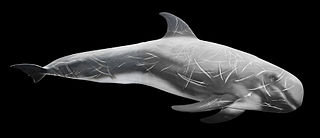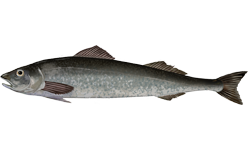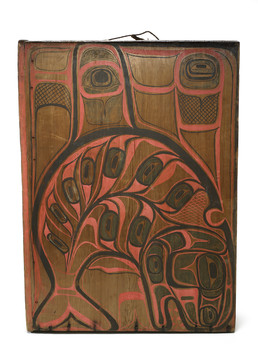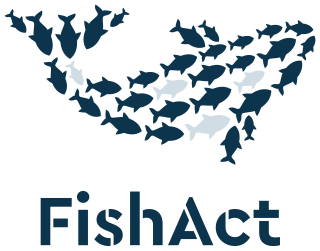Blackfish is a common name for various species of fishes and cetaceans, including:
Blackfish is a common name for various species of fishes and cetaceans, including:

The orca, or killer whale, is a toothed whale that is the largest member of the oceanic dolphin family. It is the only extant species in the genus Orcinus. Orcas are recognizable by their black-and-white patterned body. A cosmopolitan species, they are found in diverse marine environments, from Arctic to Antarctic regions to tropical seas.

The beluga whale is an Arctic and sub-Arctic cetacean. It is one of two members of the family Monodontidae, along with the narwhal, and the only member of the genus Delphinapterus. It is also known as the white whale, as it is the only cetacean to regularly occur with this colour; the sea canary, due to its high-pitched calls; and the melonhead, though that more commonly refers to the melon-headed whale, which is an oceanic dolphin.

Risso's dolphin is a dolphin, the only species of the genus Grampus. Some of the closest related species to these dolphins include: pilot whales, pygmy killer whales, melon-headed whales, and false killer whales.

Oceanic dolphins or Delphinidae are a widely distributed family of dolphins that live in the sea. Close to forty extant species are recognised. They include several big species whose common names contain "whale" rather than "dolphin", such as the Globicephalinae. Delphinidae is a family within the superfamily Delphinoidea, which also includes the porpoises (Phocoenidae) and the Monodontidae. River dolphins are relatives of the Delphinoidea.

The toothed whales are a parvorder of cetaceans that includes dolphins, porpoises, and all other whales possessing teeth, such as the beaked whales and sperm whales. 73 species of toothed whales are described. They are one of two living groups of cetaceans, the other being the baleen whales (Mysticeti), which have baleen instead of teeth. The two groups are thought to have diverged around 34 million years ago (mya).

Pilot whales are cetaceans belonging to the genus Globicephala. The two extant species are the long-finned pilot whale and the short-finned pilot whale. The two are not readily distinguishable at sea, and analysis of the skulls is the best way to distinguish between the species. Between the two species, they range nearly worldwide, with long-finned pilot whales living in colder waters and short-finned pilot whales living in tropical and subtropical waters. Pilot whales are among the largest of the oceanic dolphins, exceeded in size only by the orca. They and other large members of the dolphin family are also known as blackfish.

SeaWorld is an American theme park chain with headquarters in Orlando, Florida. It is a proprietor of marine mammal parks, oceanariums, animal theme parks, and rehabilitation centers owned by United Parks & Resorts. The parks host shows starring marine mammals, especially dolphins and pinnipeds, as well as zoological displays featuring various other marine animals.

The melon-headed whale, also known less commonly as the electra dolphin, little killer whale, or many-toothed blackfish, is a toothed whale of the oceanic dolphin family (Delphinidae). The common name is derived from the head shape. Melon-headed whales are widely distributed throughout deep tropical and subtropical waters worldwide, but they are rarely encountered at sea. They are found near shore mostly around oceanic islands, such as Hawaii, French Polynesia, and the Philippines.

The sablefish is one of two members of the fish family Anoplopomatidae and the only species in the genus Anoplopoma. In English, common names for it include sable (US), butterfish (US), black cod, blue cod (UK), bluefish (UK), candlefish (UK), coal cod (UK), snowfish, coalfish (Canada), beshow, and skil (Canada), although many of these names also refer to other, unrelated, species. The US Food and Drug Administration accepts only "sablefish" as the acceptable market name in the United States; "black cod" is considered a vernacular (regional) name and should not be used as a statement of identity for this species. The sablefish is found in muddy sea beds in the North Pacific Ocean at depths of 300 to 2,700 m and is commercially important to Japan.

Natsilane is the human hero of the "Blackfish" creation myth, one of the Tlingit and Haida stories about how the various supernatural animal species from the Tlingit culture of the American Northwest coast were created. These stories follow an almost dreamtime-like description of humans and other animal species living completely harmoniously. The animals are depicted as demi-gods, and are always referred to as proper singular nouns. There are other similar stories including how Raccoon got the rings on his tail and why Puma hides in the forest so much.

The imperial blackfish, Schedophilus ovalis, is a medusafish of the family Centrolophidae found in the eastern Atlantic and the Mediterranean Sea, and occasionally in the western Atlantic (Bermuda). It occurs at depths of between 70 and 700 m. In its juvenile stage, it is often found finding shelter amongst the tentacles of floating jellyfish, including the Portuguese man o' war. It grows to 100 cm (39 in) total length.
The wildlife of Alaska is both diverse and abundant. The Alaskan Peninsula provides an important habitat for fish, mammals, reptiles, and birds. At the top of the food chain are the bears. Alaska contains about 70% of the total North American brown bear population and the majority of the grizzly bears, as well as black bears and Kodiak bears. In winter, polar bears can be found in the Kuskokwim Delta, St. Matthew Island, and at the southernmost portion of St. Lawrence Island. Other major mammals include moose and caribou, bison, wolves and wolverines, foxes, otters and beavers. Fish species are extensive, including: salmon, graylings, char, rainbow and lake trout, northern pike, halibut, pollock, and burbot. The bird population consists of hundreds of species, including: bald eagles, owls, falcons, ravens, ducks, geese, swans, and the passerines. Sea lions, seals, sea otters, and migratory whales are often found close to shore and in offshore waters. The Alaskan waters are home to two species of turtles, the leatherback sea turtle and the green sea turtle. Alaska has two species of frogs, the Columbia spotted frog and wood frog, plus two introduced species, the Pacific tree frog and the red-legged frog. The only species of toad in Alaska is the western toad. There are over 3,000 recorded species of marine macroinvertebrates inhabiting the marine waters, the most common being the various species of shrimp, crab, lobster, and sponge.
Blackfish is a common name for several species of fish.

Orcas, also known as Killer whales, have appeared in several movies and many documentaries.

Tilikum, nicknamed Tilly, was a captive male orca who spent most of his life at SeaWorld Orlando in Florida. He was captured in Iceland in 1983; about a year later, he was transferred to Sealand of the Pacific near Victoria, British Columbia, Canada. He was subsequently transferred in 1992 to SeaWorld in Orlando, Florida, where he sired 21 calves throughout his life.

Blackfish is a 2013 American documentary film directed by Gabriela Cowperthwaite. It concerns Tilikum, an orca held by SeaWorld and the controversy over captive orcas. The film premiered at the 2013 Sundance Film Festival on January 19, 2013, and was picked up by Magnolia Pictures and CNN Films for wider release. It was nominated for the BAFTA Award for Best Documentary.

FishAct is an international marine conservation and activism organisation based in Amsterdam, Netherlands. Its name was changed in 2018 to FishAct. FishAct's stated mission is to "end the industrial overfishing of the oceans" and to "empower individuals to get actively involved in building grassroots citizen-led conservation communities". The non-governmental organisation was founded in 2010 and has active local chapters in Germany and the United Kingdom. To achieve its goals, the organisation uses a combination of investigation, education, and non-violent direct-action. Campaigns have included gathering support for the release of captive cetaceans, actions against dolphin drive hunts and campaigning to end overfishing of the endangered bluefin tuna in the Mediterranean Sea.

Yup'ik cuisine refers to the Eskimo style traditional subsistence food and cuisine of the Yup'ik people from the western and southwestern Alaska. Also known as Cup'ik cuisine for the Chevak Cup'ik dialect speaking Eskimos of Chevak and Cup'ig cuisine for the Nunivak Cup'ig dialect speaking Eskimos of Nunivak Island. This cuisine is traditionally based on meat from fish, birds, sea and land mammals, and normally contains high levels of protein. Subsistence foods are generally considered by many to be nutritionally superior superfoods. Yup’ik diet is different from Alaskan Inupiat, Canadian Inuit, and Greenlandic diets. Fish as food are primary food for Yup'ik Eskimos. Both food and fish called neqa in Yup'ik. Food preparation techniques are fermentation and cooking, also uncooked raw. Cooking methods are baking, roasting, barbecuing, frying, smoking, boiling, and steaming. Food preservation methods are mostly drying and less often frozen. Dried fish is usually eaten with seal oil. The ulu or fan-shaped knife is used for cutting up fish, meat, food, and such.

Orcas or killer whales have a cosmopolitan distribution and several distinct populations or types have been documented or suggested. Three to five types of orcas may be distinct enough to be considered different races, subspecies, or possibly even species. The IUCN reported in 2008, "The taxonomy of this genus is clearly in need of review, and it is likely that O. orca will be split into a number of different species or at least subspecies over the next few years." Although large variation in the ecological distinctiveness of different orca groups complicate simple differentiation into types. Mammal-eating orcas in different regions were long thought likely to be closely related, but genetic testing has refuted this hypothesis.